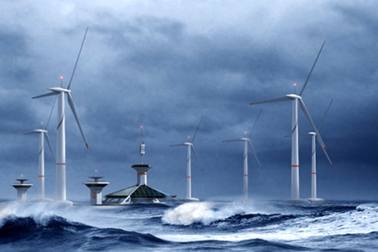 The tiny island nation of Malta is lagging. As a member of the European Union, Malta is supposed to get 10% of its energy from renewable sources by 2020. Currently, the country’s at 1% to 2%. Whoops. To catch up quickly, Malta is considering a proposal by the Swedish company Hexicon to build the world’s largest floating wind farm. It would consist of 36 turbines arranged around a 460-meter-wide platform, teth ered to the ocean floor by cables. The proposed site for the platform is 11 nautical miles off the island’s northeast shore. It would be far enough away to take advantage of high ocean winds (and be more or less out of sight) yet close enough that it could be connected to the country’s electricity grid without too much trouble. Its total power capacity: 54 megawatts. The platform’s turbines are estimated to be able to provide about 9% of Malta’s power on its own, pushing the country past the 10% renewables target. The project isn’t quite green-lit yet. Its potential effects on bird migration and marine life still have to be assessed and funding isn’t locked down (Malta is hoping to get financing from the EU’s excellent NER300 program). But if everything goes according to plan, it could be up and running by the summer of 2014. The vast majority of offshore wind turbines are pile-driven into the seabed. Floating wind turbines like these are a very new technology: The first was deployed off the coast of Italy in 2007. To date, there are just a handful of functioning floating turbines and the largest has a capacity of only 2.3 megawatts. But floating turbines have many potential advantages. They can be sited in much deeper waters, where they can harvest the energy from high winds while not interfering with shipping lanes or coastal views. They also may be easier to maintain or update. Malta’s floating wind farm would be the world’s largest by an order of magnitude–but it could also be an important proof-of-concept for other countries. Courtesy of http://www.fastcoexist.com
The tiny island nation of Malta is lagging. As a member of the European Union, Malta is supposed to get 10% of its energy from renewable sources by 2020. Currently, the country’s at 1% to 2%. Whoops. To catch up quickly, Malta is considering a proposal by the Swedish company Hexicon to build the world’s largest floating wind farm. It would consist of 36 turbines arranged around a 460-meter-wide platform, teth ered to the ocean floor by cables. The proposed site for the platform is 11 nautical miles off the island’s northeast shore. It would be far enough away to take advantage of high ocean winds (and be more or less out of sight) yet close enough that it could be connected to the country’s electricity grid without too much trouble. Its total power capacity: 54 megawatts. The platform’s turbines are estimated to be able to provide about 9% of Malta’s power on its own, pushing the country past the 10% renewables target. The project isn’t quite green-lit yet. Its potential effects on bird migration and marine life still have to be assessed and funding isn’t locked down (Malta is hoping to get financing from the EU’s excellent NER300 program). But if everything goes according to plan, it could be up and running by the summer of 2014. The vast majority of offshore wind turbines are pile-driven into the seabed. Floating wind turbines like these are a very new technology: The first was deployed off the coast of Italy in 2007. To date, there are just a handful of functioning floating turbines and the largest has a capacity of only 2.3 megawatts. But floating turbines have many potential advantages. They can be sited in much deeper waters, where they can harvest the energy from high winds while not interfering with shipping lanes or coastal views. They also may be easier to maintain or update. Malta’s floating wind farm would be the world’s largest by an order of magnitude–but it could also be an important proof-of-concept for other countries. Courtesy of http://www.fastcoexist.com
Malta Will Build the World’s Largest Floating Wind Farm

